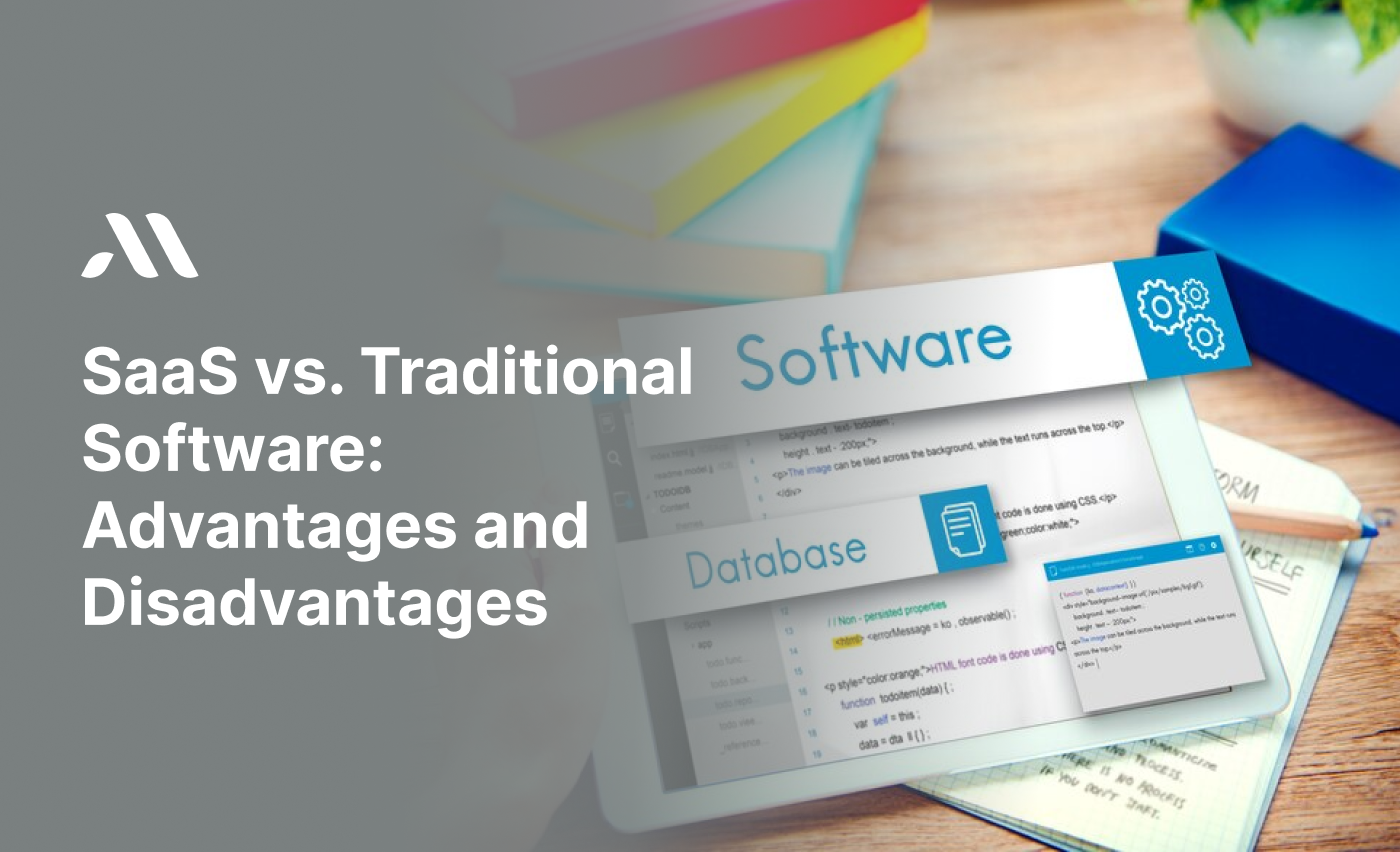When it comes to choosing the right software for your business or personal use, you can find yourself deciding between SaaS vs. Traditional Software. But what exactly are these, and what makes them different? Let’s jump into this topic, exploring the advantages and disadvantages of each.
What is SaaS?
SaaS, or Software as a Service, is a type of software that you access online. Instead of buying the software outright, you usually pay a monthly or yearly fee to use it. Examples include Google Docs, Dropbox, and Netflix. SaaS Development is how these applications are created to be used over the internet.
What is Traditional Software?
Traditional Software is software that you buy and install on your computer. You pay for it once, and it stays on your device. Examples include Microsoft Office (the version you buy and download), Adobe Photoshop, and certain video games. Traditional Software Development involves creating these types of programs for specific devices like your PC or Mac.
Statistics show that by 2024, SaaS will make up over 80% of total software usage. This reflects how popular and convenient it has become for both businesses and individuals.
“The best software solution depends not just on the present needs but also on the future growth and adaptability of your business.”
Advantages of SaaS
One of the biggest SaaS Advantages is that it’s easy to use. You don’t need to install anything. You just log in and start working. This is great for people who aren’t very tech-savvy or don’t want to deal with the hassle of installation.
Another SaaS Advantage is that it’s accessible from anywhere. Whether you’re at home, at work, or on vacation, as long as you have an internet connection, you can use the software. This makes SaaS Development popular for businesses with remote workers.
SaaS also tends to be cheaper upfront. Instead of paying a large amount of money to buy software, you pay smaller amounts over time. This makes it easier for startups and small businesses to get the tools they need without breaking the bank.
Also Read - Top Trends in SaaS Development for 2024
Advantages of Traditional Software
Traditional Software has its own set of advantages. First, once you buy it, it’s yours. There’s no need to keep paying to use it, which can be a good deal in the long run, especially if you use the software for many years.
Another advantage is that Traditional Software usually works without the Internet. This is great if you don’t always have a reliable internet connection or if you’re concerned about data privacy.
Traditional Software Development helps for more customization. Because the software is installed directly on your computer, it can be tailored to work perfectly with your specific system and needs.
Disadvantages of SaaS
While SaaS has many benefits, it also has some drawbacks. One of the biggest is that you need a stable internet connection. If your internet goes down, you can’t use your software. This can be a big problem for businesses that rely heavily on their software.
Another disadvantage is that you never really own the software. You’re essentially renting it. If you stop paying, you lose access to it.
There’s also the issue of data security. Because SaaS is hosted online, your data is stored on the provider’s servers. This can be a concern for those who deal with sensitive information and prefer to keep their data in-house.
Disadvantages of Traditional Software
Traditional Software isn’t without its flaws either. One major disadvantage is the cost. You usually have to pay a large amount upfront, which can be a barrier for small businesses or individuals on a tight budget.
Another downside is that Traditional Software can become outdated. Technology changes quickly, and what was cutting-edge a few years ago can not work as well today. Updating traditional software often requires buying a new version, which can be costly.
Lastly, Traditional Software is limited to the device it’s installed on. If you want to use it on multiple devices, you might have to buy additional licenses, which can add to the cost.
Making the Right Choice: SaaS vs. Traditional Software
When deciding between SaaS vs. Traditional Software, it’s important to consider your specific needs. Here’s a quick tip: Tip: If you need flexibility and don’t mind a monthly fee, go with SaaS. If you prefer to own your software and don’t want to rely on the internet, traditional software might be better.
SaaS vs. Traditional Software for Businesses
For businesses, the choice between SaaS vs. Traditional Software can significantly impact operations. SaaS Development is favoured by many companies because it helps for easy scaling. As your business grows, you can easily add more users to your SaaS platform without worrying about installing software on multiple devices.
Also, Traditional Software Development can be more rigid. If your business needs change, upgrading or adding more licenses can be costly and time-consuming.
However, businesses that prioritize data security and have specific customization needs might prefer Traditional Software. This is particularly true for industries that deal with highly sensitive information, such as healthcare or finance.
Also Read - Top SaaS Development Tools for 2024
SaaS vs. Traditional Software for Personal Use
For personal use, the choice often comes down to convenience vs. ownership. If you like to have the latest features and don’t mind paying a little each month, SaaS is likely the best option. You’ll always have access to the most up-to-date version of the software, and you can use it from any device.
On the other hand, if you prefer to make a one-time purchase and use the software for years without worrying about ongoing fees, Traditional Software can be more amazing
Remember: It’s essential to think about your future needs when choosing between SaaS vs. Traditional Software. What works for you today might not be the best option a few years down the road. For example, if you plan to expand your business, SaaS might offer more flexibility and scalability.
Conclusion
In conclusion, both SaaS vs. Traditional Software have their pros and cons. SaaS offers flexibility, ease of use, and affordability, making it an excellent choice for many businesses and individuals. However, it requires a reliable internet connection and ongoing payments. On the other hand, Traditional Software provides ownership, offline access, and more customization but comes with higher upfront costs and potential limitations in scalability.
Unlock the power of the right software with MicraSol! Whether you need a flexible SaaS solution or reliable Traditional Software, our expert team is here to help. Contact us today and find the perfect fit for your business needs. Let’s make your software dreams a reality.
By weighing the SaaS Advantages against the benefits of Traditional Software Development, you can make an informed decision that best suits your needs. Whether you choose SaaS Development or stick with the tried-and-true methods of Traditional Software, understanding the differences will help you make the right choice.
Note: Always review your software needs regularly to ensure that you’re using the best option for your evolving requirements. Technology is constantly changing, and what works today may need an update tomorrow.
FAQS
What is SaaS?
SaaS stands for Software as a Service. It's a type of software you use online without needing to install anything on your computer. You just log in and start using it, like Google Docs or Netflix.
What is Traditional Software?
Traditional Software is the kind you buy and install directly on your computer. Once you buy it, you can use it without needing the internet, like Microsoft Office or certain video games.
Which is cheaper: SaaS or Traditional Software?
SaaS is usually cheaper upfront because you pay a small monthly fee instead of a big amount all at once. However, over time, the cost can add up. Traditional Software costs more upfront, but you only pay once.
Can I use SaaS without the internet?
No, SaaS requires an internet connection to work. If you don’t have a reliable internet connection, you might have trouble using SaaS.
Do I own the software with SaaS?
No, with SaaS, you’re essentially renting the software. You pay to use it, but you don’t own it. If you stop paying, you lose access.








